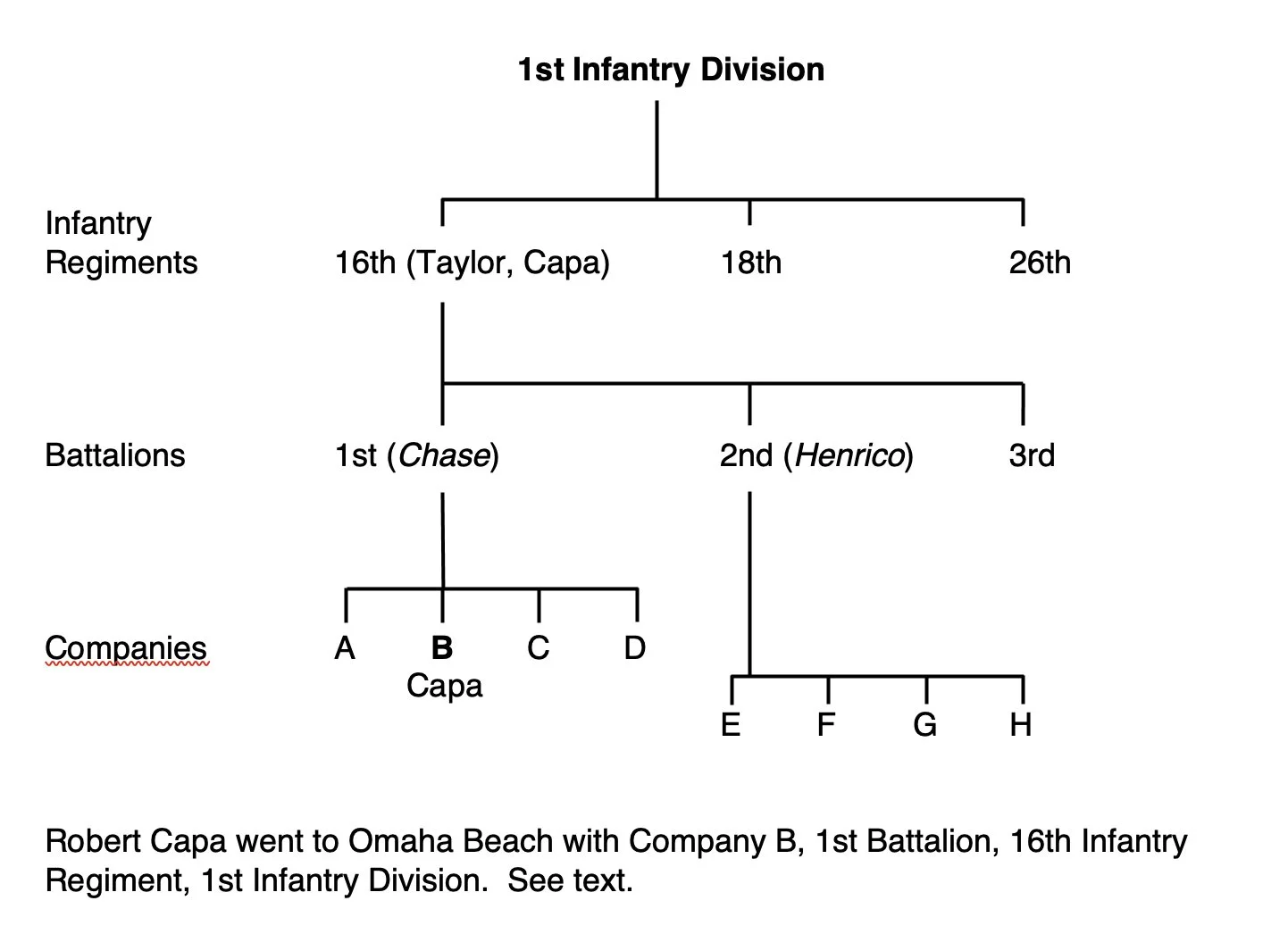It is necessary to pause for a moment to define a few concepts.
Regiments and Companies
First, it's important to understand the organization of the Army as it relates to Omaha Beach. The United States Army has many units, which have subunits, which have subunits, etc. Capa was assigned to an infantry unit – ground troops – so I will concentrate on that.
The largest infantry unit is the Division, and there are many of those. Omaha Beach was assaulted by the First Infantry Division, AKA the Big Red One, and the 29th Infantry Division, AKA the Blue and Gray.
Divisions are divided into Regiments (Brigades). Regiments are divided into Battalions. Battalions are divided into Companies. Up to 200 personnel comprise a Company.
On D-Day, the 16th Regiment of the First Infantry assaulted Omaha Beach under Colonel George A. Taylor's command. The First Battalion of these troops were transported to France on the U.S.S. Chase. The Second Battalion were on the U.S.S. Henrico.
Capa was on the U.S.S. Chase, which means he was with the First Battalion. He was originally slated to ride to the beach in the Colonel Taylor's LCVP. But Taylor switched his entire group of out the more spacious LCM (Landing Craft Mechanized) and into a more maneuverable LCVP (Landing Craft Vehicle/Personnel), otherwise known as the Higgins boat. The Higgins boat can hold about 33 to 36 outfitted soldiers, whereas the LCM can hold up to 100.
Wave
The wave of troops that Capa claimed to have accompanied is severely contested by Clan Coleman. They say that he flat out lied about going in with the first wave, and are quite vituperous about it.
The term, "wave" as it applies to amphibious assault, is a malleable term. On D-Day, the first Company from the Big Red One to arrive at the beach was Company E, aboard many LCVP's from the Henrico. So, in one sense, the men in the first landing craft with Company E were the first wave.
However, "wave" can also mean the arrival of boats from a specific Troop Carrier, like the Henrico or the Chase. The Coast Guard referred to the first wave from the Chase, meaning the first troops to arrive from her. The first wave of troops from the Chase would have arrived at Omaha Beach after the first wave of troops from the Henrico, making them second wave overall. Very confusing.
"First wave" has also been used to describe all the troops that arrived on Omaha Beach on June 6, the first 24 hours.* So, the term "wave" is ambiguous and should not be interpreted with the specificity assigned to it by Coleman and colleagues, who continually harangue Capa for his claim to go in with the first wave.
E. K. Butler of the Associated Press Newsphoto Service, was the editor and supervisor of production for the U.S. Wartime Still Photo Pool during the invasion. He reported, "Going in with the first assault waves were Peter Carroll of AP, Bob Capa and Bob Landry of Life, and Bert Brandt of Acme." **
Herrick did not include this quote, even though he quoted other parts of this article, presumably because it does not support his contention that Capa did not go in with the first waves. This is another example of selective scholarship.
Personally, I don't see that it matters one bit whether someone arrived on the very first boat, or 20 boats behind them. They all faced the same fortified enemy; they all faced the very real possibility of death. To distinguish the order in which these men arrived, as Coleman and his friends have done, impugns the honor of many who served that day.
Fog of War
The other concept that relates to this story is the fog of war. This generally refers to uncertainty experienced during and after complex and stressful events, such as combat. The memories of soldiers who experienced the same event can vary significantly. Lack of communication, command and control exacerbates the fog of war. Lack of situational awareness plays a large part in the fog of war. Fear, of course, amplifies and distorts perception of reality, which contributes to the fog of war. The Coleman Clan appear to dismiss this concept, demanding absolute, precise accuracy from their human historical sources.
Bottom Line
I have shown that the term “first wave” is ambiguous, even in military settings among service members. I doubt if SHAEF informed Robert Capa of the overall plan for Operation Overlord, specifically telling him that men of E Company would be the “first wave.” It is more likely that the officers on board the U.S.S. Chase, in their briefing which Capa attended, mentioned that men from B Company would be in the first wave from that ship. In this sense, Capa would have been right to have claimed to have gone in with “the first wave.” But in reality, it doesn’t matter. He, and the other men that day, faced incredible personal danger by going at all. The argument can made that it was even more courageous for a civilian, noncombatant to volunteer for the mission than for a trained soldier to go. But this nitpicking about the correct technical use of the term “first wave,” when military people can’t agree on it, is pointless. [Ed. note: this paragraph added 11/13/25.]
* In his book, The First Wave, written specifically about the first wave of troops to land on Omaha Beach, Alex Kershaw considers all the men who assaulted Normandy that day, including paratroopers, to have been in the first wave. (Alex Kershaw. The First Wave. The D-Day Warriors who led the way to Victory in World War II. Dutton Caliber, An imprint of Penguin Random House LLC. 2020 [footnote added May 28, 2025]
** Editor and Publisher, 1944-11-18: Vol 77 Iss 47

